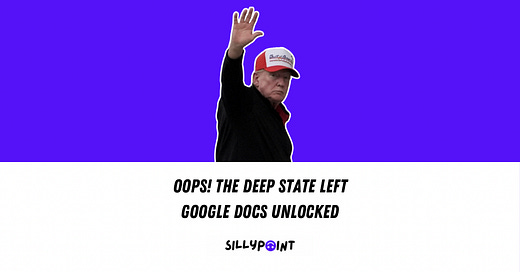Your Tax Dollars at Work Just Leaked the White House Floor Plan
Sensitive blueprints, blast door specs, and vendor banking info were shared with 11,000+ federal employees. Oops.
America is a country that can 3D-print hypersonic missiles and lose nuclear warheads in the ocean—but apparently, it can’t manage Google Drive settings.
Over the past four years, federal employees have been accidentally sharing sensitive documents—including White House blueprints, blast door designs, and banking details—with everyone at the General Services Administration.
That’s more than 11,000 people.
Some of these documents weren’t just “for your eyes only”—they were “editable by all.”
You know, just in case Steve in Accounting wanted to redesign the West Wing Situation Room over lunch.
Bureaucratic Incompetence Is the Real Deep State
Forget shadow governments and secret cabals—our actual vulnerability is Google Workspace.
What this leak reveals is not a grand conspiracy, but an almost comically banal one: government employees who never learned how to use cloud permissions.
And it’s not new. From Clinton’s email server to Jared Kushner’s WhatsApp diplomacy to Biden’s garage storage system, every administration has its own flavor of digital recklessness.
America isn’t being run by geniuses plotting a fourth-dimensional chess game. It’s being run by people who still think “the cloud” is a physical place.
Apathy in Action
Who benefits from this mess? Not nation-states, not whistleblowers, not even journalists. Just pure inertia.
Career GSA employees, acting without malice but full of muscle memory, shared sensitive information through internal folders that defaulted to “anyone can edit.” The agency allegedly scans for these things, offers annual training, and investigates mistakes—but clearly, it’s not working.
If you’re wondering how this could go on for years, remember: the only thing more permanent than a government program is a Google Doc no one closes.
Security Theater in a Digital Janitor’s Closet
While TSA frisks toddlers and the NSA hoards terabytes of encrypted selfies, the blueprints to the White House just sat in a shared folder, editable by 11,000 federal workers. Editable. Imagine you’re a night-shift janitor at GSA and suddenly you have the power to alter the Situation Room’s emergency egress routes.
And yes, while the documents were technically marked as “Controlled Unclassified Information” (CUI), that’s government-speak for: “Don’t leak this, but we didn’t bother classifying it properly.” It’s the bureaucratic version of leaving your house key under the welcome mat but writing “Do Not Steal” on it in Sharpie.
We’re Not a Banana Republic—We’re a PDF Republic
This isn’t espionage. It’s entropy.
As federal agencies digitize everything, the line between sensitive and shareable blurs. The system isn’t built for 21st-century information flows. It’s built for 1990s filing cabinets with floppy disk backups.
But the real question: What does it say about a superpower when its own blueprints can be accidentally shared with a softball league-sized staff, and no one notices for four years? Is secrecy even real anymore—or just a file extension away from a mistake?
This wasn’t a hack. It wasn’t a leak. It was a shrug. A casual mistake that lasted through two presidencies, survived annual IT trainings, and only got caught during a random audit. And the lesson isn’t about Trump or Biden—it’s about the soft underbelly of American governance: a system that can drop a drone on your house, but can’t tell who has access to it.
So next time someone says government is inefficient, remember: it’s worse than that. It’s accidentally transparent.
And somewhere in the depths of a GSA inbox, someone is still wondering: Do you want to request edit access to the blast door specs?
That’s the point.





